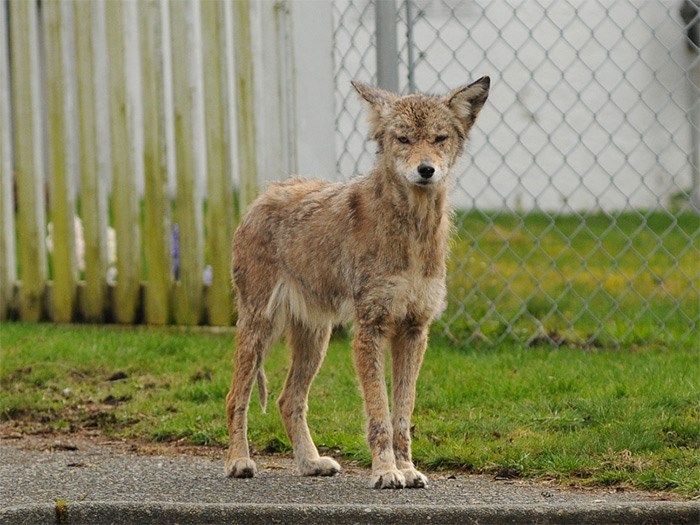 Springtime is birthing season for coyotes, and that means increased sightings across the city as mothers venture out from their dens in order to seek food for their new pups. Photo Dan Toulgoet
Springtime is birthing season for coyotes, and that means increased sightings across the city as mothers venture out from their dens in order to seek food for their new pups. Photo Dan Toulgoet
They may not have the resources of the ACME Corporation behind them, but coyotes are still causing trouble for people, and their pets, in Vancouver.
It’s currently birthing season for the canines, and that means coyote sightings are up as mothers venture out from their dens in order to seek food for their new pups.
This in turn leads to increased encounters with humans, which can be dangerous for both us and our furry friends. Two incidents in the North Shore in April resulted in the deaths of a pair of dogs after they encountered coyotes while out for a walk with their owners.
There have also been several cases of coyotes killing cats in the past few months.
To reduce such incidents, the Stanley Park Ecology Society is advising residents how to keep their pets safe, as well as how to handle a coyote encounter.
“We say be big, be brave, and be loud,” says Greg Hart, the urban wildlife program coordinator for SPES.
Hart explained this three step process in more detail: “Hold your arms out to make yourself big. Be brave, don’t run.” And finally, “Clap your hands, stomp your feet, take a step towards the animal and say, ‘Go away coyote!’”
Coyotes are not especially large animals, weighing on average between 15 to 45 pounds and measuring about a metre in length. While they may not pose much threat to humans — as long as they are not in a pack — it’s a different story for small pets.
Dogs and cats are prime targets for wandering coyotes.
First and foremost, keep yards clear of food and other attractants that could draw the attention of an inquisitive mother coyote. “Coyotes living in our city are viewing our homes, our yards, as habitats. They’re looking for food, water and shelter,” Hart says. “It’s really easy for us to make sure that our garbage goes in the garbage can, that we harvest our fruits and vegetables, and we keep our compost secure.”
SPES also recommends keeping your dog on a leash when going out for walks, especially at night. Both dogs killed in the North Shore last month were off leash at the time of the attacks.
Keeping cats safe can be more difficult due to their solitary nature and desire to wander. SPES strongly advises keeping cats indoors if possible. Barring that, keeping them inside during the night will reduce the chances of encounters with the largely nocturnal coyotes.
Hart also says under no circumstances should people feed coyotes, no matter how friendly they may appear. Not only is it illegal to do so under the B.C. Wildlife Act, but it also causes coyotes to lose their fear of humans, which in turn leads to more unwanted encounters.
One tool that SPES has deployed in order to help gather information about interactions with coyotes is the Co-Existing with Coyotes program, which tracks various forms of coyote encounters in Metro Vancouver.
The program relies on citizens who — after encountering a coyote — go to the SPES website and fill out a report detailing what they saw. The encounters are then displayed on an interactive map, which lists the date, time and location of the sighting. Sightings are also filtered by type, including attacks on pets, people feeding coyotes, or even if the coyote was aggressive towards people.
Hart says keeping these rules in mind will benefit both species in the long run.
“Help out, do site visits [on the Co-Existing with Coyotes website], scare away coyotes, and help reduce these conflicts so we can co-exist and people can be happy.”
@akurial


